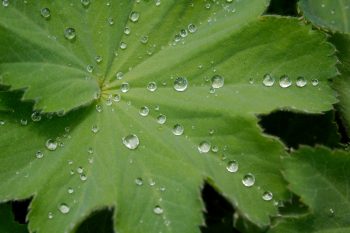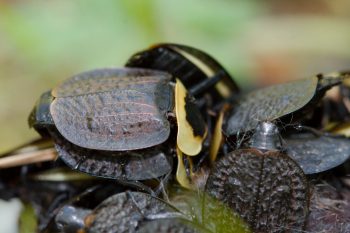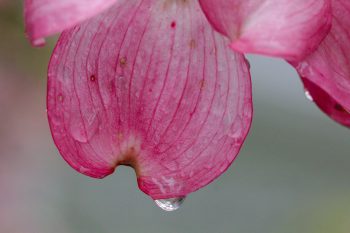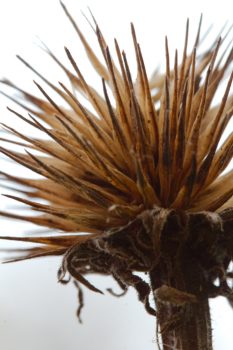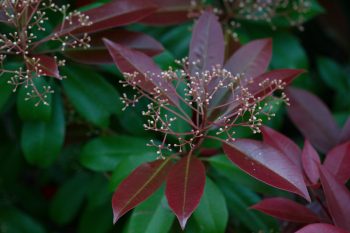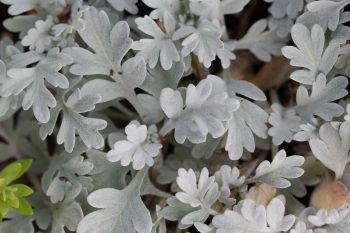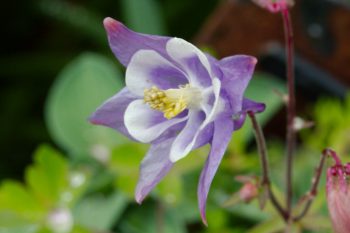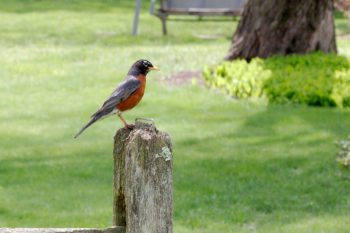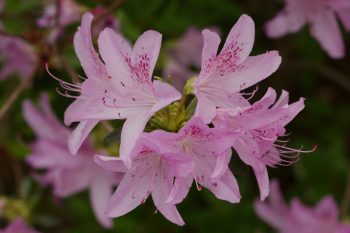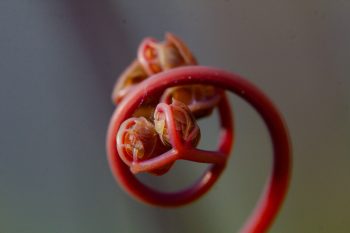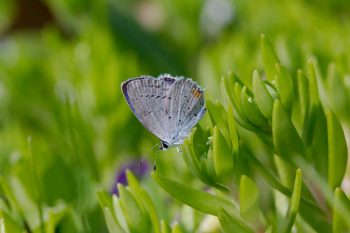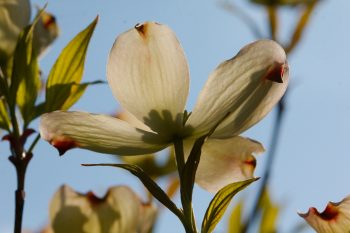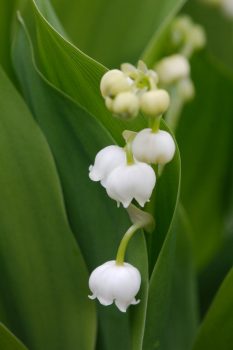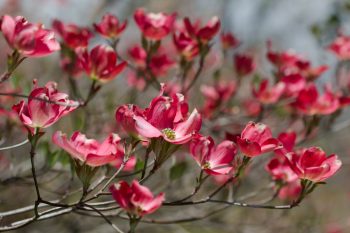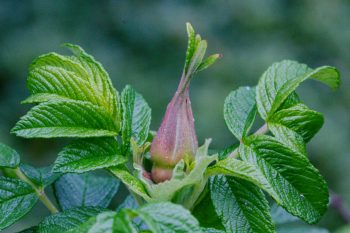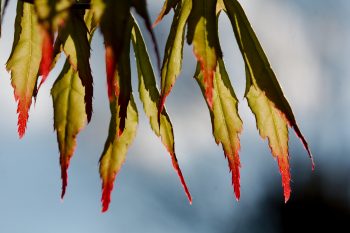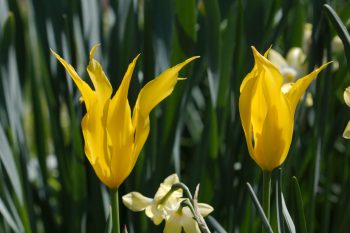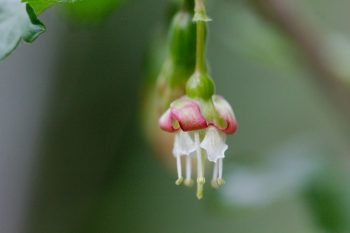It’s a week early for Mother’s Day but we’ve been cooped up for too long and we didn’t want to wait until next week. We took our annual trip to Fehr’s Nursery early this afternoon and Cathy bought a load of plants. As usual, I wandered around and took photos of flowers, etc. I got some nice pictures of various hens and chicks (Sempervivum varieties) including some Sempervivum arachnoideum, which have what look like cobwebs on them. I decided to go with this photo, however, of lady’s mantle leaf (Alchemilla mollis ‘Auslese’) with water droplets on it.
Alchemilla mollis ‘Auslese’
Necrophila americana (American Carrion Beetle)
We took a walk near Lake Frank today and had a really nice time. We saw one adult and one juvenile bald eagle next to and on the nest across the lake. It’s too far, really, to get a good picture but I did take a few, anyway, just to record the fact. We happened to come across this pile of American carrion beetles (Necrophila americana), presumably on a piece of carrion. They were definitely there for a reason. It’s fine to get grossed out by them, but then, without them, the rotting meat would stick around a lot longer, so in my book, they’re doing us a service.
Squirrel on a Cow Skull
Cathy and I were out in the back yard and we heard a scratching noise. We’re used to quite a bit of noise from birds and occasional tree frogs, but this was quite different and we didn’t recognize it. We finally noticed this squirrel on the cow skull that’s hanging on our back fence. The squirrel, in typical rodent fashion, was gnawing on the top of the skull. I assume it’s gnawing on the bone to get calcium and other nutrients. Anyway, it’s one of the reasons you only find relatively fresh bones in the wild. They don’t last long unless they get buried (and probably even then).
Dogwood Petal
We had some significant rain today. I don’t mind too much, as it’s spring and it’s the time of year you expect rain. The ground gets good and soaked and the plants really enjoy it. Things are greening up all over. The pink dogwood in front of our house is just about finished blooming and this rain storm is speeding up the petal drop. I really love water on flowers, though, so when I went out this evening, that’s what I looked for. The forecast is for more rain on Saturday and then warm and sunny on Sunday. We’ll see, of course.
Echinacea purpurea
This is purple coneflower (Echinacea purpurea) although obviously there isn’t any purple color here right now. These are last year’s seeds, which we generally leave up all winter for the birds. They are obviously well fed, because by spring, most of them are still here. It’s just about time we cleared them all out. Most of the black-eyed Susan seed stalks have been cleared, although we’ve left some yet.
I was on the ground taking photos of a columbine (Aquilegia) and happened to notice this coneflower stem next to me, so I rolled over on my back and took a few shots, hoping to get a little detail in the seeds, which were seriously back-lit by the sky. This one turned out pretty well. I would have liked to get a little further away, as well, but I was looking nearly straight up and getting further away would have required that I dig a hole to get into. So, not going to happen.
Photinia × fraseri
Cathy and I took a walk in the neighborhood this evening. That’s been something we’ve done a lot more of since we can’t really go out as we once did. Spending time outdoors is important for mental health, I think, and particularly in the spring when the weather is so nice, it’s a real blessing to be able to get out. These are the leaves and flower buds of a Photinia × fraseri shrub around the corner from our house. As you can see, the new leaves are red and it’s quite a striking plant, particularly when growing in full sun, where the color can be even more stunning. Photinia × fraseri is a hybrid of P. glabra (Japanese photinia) and P. serrulata (Taiwanese photinia).
Dusty Miller
Dusty Miller (Jacobaea maritima, a.k.a. Senecio cineraria) is a marginally hardy, herbaceous perennial. It’s hardy here, anyway. We have it growing in an urn-shaped container near the end of our driveway and it seems happy enough. It does have flowers but they are not particularly ornamental and many people prune them off so as not to distract from the foliage, which is what the plant is generally grown for. It does well in both shade and sun and really takes very little care.
Columbine (Aquilegia)
We have a number of different columbines in our yard and garden. This one is growing in a container just outside our front door. This is a relatively simple columbine flower, close to what you’d find in the wild. Some others that we have are much fancier and I’ll probably have photos of them in the days to come. They are a reliable bloomer and well worth adding to your garden, blooming after the bulbs are mostly done and before the summer blooms start, so they fill an important role in the garden plan.
American Robin (Turdus migratorius)
One of the most common birds in our area, winter or summer, is the American robin (Turdus migratorius). They are always around, in the lawn, in trees, singing and making a racket throughout the day. They aren’t anywhere near as cute as the European robin (Erithacus rubecula), which is classified as an Old World flycatcher (family Muscicapidae) rather than a thrush (family Turdidae), which is where the American robin stands. Although they are migratory (as their specific epithet suggests), their winter and summer ranges overlap and they can be seen year round through nearly all of the contiguous 48 states.
Hosta Leaf
Cathy bought a couple hosta plants last year and put them in a container in the front of our house. If we grow them quite close to the house they do reasonably well but the deer and rabbits really seem to like them and if they are farther from the house, they get eaten. Of course the slugs are just about as likely to get them close to the house, but they don’t consume an entire plant over night. This one, called ‘First Frost’, is one of the two that are in this container and it such a pretty little things.
Azaleas
Cathy and I took a break in the early afternoon and took a walk in the neighborhood. We got mail for someone else delivered to us (same house number, different street, happens fairly often) and we wanted to take it to the correct address. I carried my camera, as I usually do on walks, and took pictures of a few azaleas starting to bloom in the neighborhood. There are quite a lot around here, although most are just starting to come out. Soon the neighborhood will be full of color. Actually, it’s already full of color, but there will be more and different colors.
Maidenhair Fiddlehead
Our northern maidenhair fern (Adiantum pedatum) is coming up in the back garden. It’s really in much too sunny a spot and I think this year I really will split it and move at least some of it to a shadier, less dry spot. It does surprisingly well here, even so, only getting a bit burned late in the summer, especially in particularly dry years. It’s easily grown and one that should be in more gardens. I also think this is the year I’ll get a royal fern (Osmunda regalis), which has been on my wish list for a long while. Who knows, maybe I’ll even get around to making a water feature and bog garden.
Eastern Tailed-Blue (Cupido comyntas)
You can pretty much be sure that if there are things blooming, there are at least a few insects about. Insects aren’t the only pollinators, of course but they do the lion’s share of the work. Nevertheless, they are not out in numbers that we’ll see later in the year. I saw and photographed two different insects today. This one is an eastern tailed-blue (Cupido comyntas) and the other was a syrphid flies (Syrphidae, probably Toxomerus geminatus). So, the insect season is getting underway.
Flowering Dogwood
I recently had a photo of dogwood leaves (see Thursday, April 09, 2020) which got some positive feedback. This is a flower on the same tree, a seedling that’s been growing on the edge of a flower bed in our back yard. I’m of two minds about this tree. On the one hand, any flowering tree has merit. On the other it’s not really where I’d want a flowering tree. There was a large silver maple (Acer saccharinum, not to be confused with Acer saccharum, the sugar maple) here but we had it cut down because it was large enough and leaning towards our house enough that we got very nervous every time there was a storm. We have a perennial bed where it once was, the this tree is right on the edge of that.
Lily of the Valley (Convallaria majalis)
The lily of the valley (Convallaria majalis) is starting to bloom. We have it in a few places around the yard and these are at the front corner of our house where they get just a bit more sun than the other places so are a little ahead. It’s a lovely plant and has lovely, sweetly fragrant flowers but all parts of the plant are very poisonous so if that makes you nervous, you might want to avoid it. It contains cardiac glycosides, “a class of organic compounds that increase the output force of the heart and increase its rate of contractions.”
We dug some up in a yard that was being torn up when a road was being widened and it was growing through asphalt paving, so it’s pretty tenacious. We have it in a fairly large bed in the back yard but it is actually being forced outward by Vinca minor which I wouldn’t have thought possible.
Pink Flowering Dogwood
I know I’m repeating myself but this pink flowering dogwood (Cornus florida) is so beautiful I cannot help myself. It’s really loaded with flowers and they deserve to be seen. This tree is growing much too close to the house and I really need to get rid of it. I planted a camellia in front of it with the thought that when that gets big enough to stand on its own, I’d cut down the dogwood. That’s the flower I posted back on Wednesday, April 01, 2020 but as small as it is, I’m not sure I really can wait that long to get rid of this tree. So, enjoy it while you may.
Rugosa Bud and Leaves
I lost many of my roses over the last two years do to mostly unknown circumstances. One that only mostly died is Rose ‘Roseraie De l’Hay’, a large R. rugosa hybrid bred by Jules Gravereaux (France, 1901). It’s a generally healthy, easily grown shrub getting 7 or 8 feet tall here and with deep green leaves and crimson-purple, very fragrant flowers. Thankfully, one major stem is doing fine and since that means the roots are still alive, I have every hope that it will send up new canes.
Maple Leaves
I had a photo of dogwood leaves coming out of their buds recently (see Thursday, April 09, 2020) and they were pretty well liked on Instagram. That tree is a volunteer seedling that has been growing in a large bed in our back yard there there was once a large silver maple tree. That bed has been left pretty much to itself for quite a few years although we starting taking it back last summer and will do more this year. Along with the flowering dogwood (Cornus florida) there is a small maple seedling coming up. It’s close enough to the dogwood that we cannot really keep them both, but before I cut it out, I thought I’d post a photo of the new leaves coming out on it. It appears to have Japanese maple (Acer palmatum) in it’s makeup. But it’s going. Sorry.
Tulipa acuminata
Where there used to be a large oak tree in our front yard (technically in the road right-of-way) there is now a small garden bed. Around the tree was Pachysandra terminalis and that’s still there. Where the tree was Cathy plants annuals and there are some tiger lilies there now, as well, which seem to enjoy the spot. Around the permimeter are daffodils of various types, all different shades of yellow. They look bright yellow until these fireflame tulips (Tulipa acuminata) start to bloom with their really intense yellow flowers.
Gooseberry Flower
The plant this gooseberry flower is on was one that Albert had growing in his yard. Brady left me dig it up before she moved out of that house and it’s done very well against our back fence. Dorothy made little tarts with gooseberries from it last year and it looks to have a pretty good crop again this year, if the number of flowers tells us anything. The flowers are generally considered insignificant, at least from an ornamental standpoint. They are quite small and not particularly showy except from very close but they are actually pretty little things. The gooseberry (Ribes uva-crispa) is native to Europe, N. Africa, and the Caucasus and is, as you’d guess, primarily grown for it’s wonderfully tart fruit. The leaves of gooseberries contain hydrogen cyanide, a toxin that, in sufficient quantities, is pretty bad for you.

